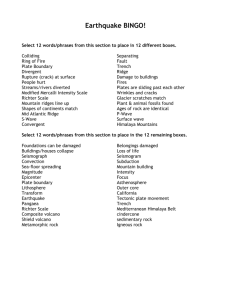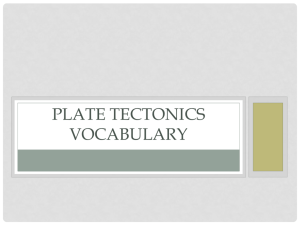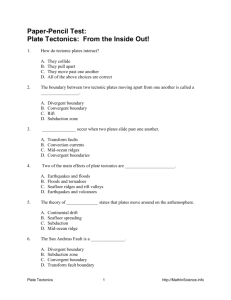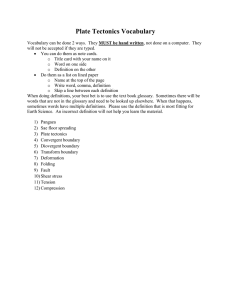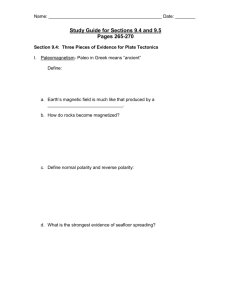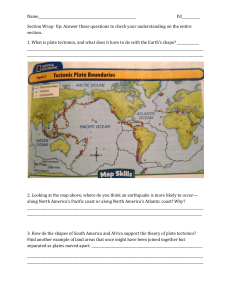Chapter 8 Topic Questions: Plate Tectonics
advertisement
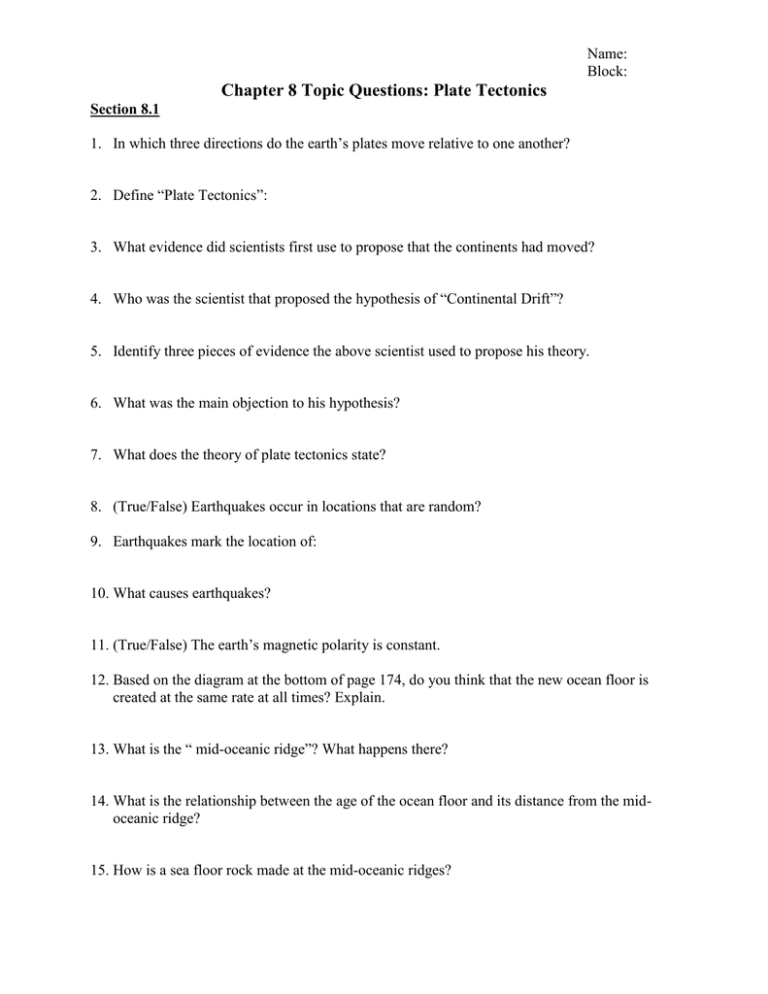
Name: Block: Chapter 8 Topic Questions: Plate Tectonics Section 8.1 1. In which three directions do the earth’s plates move relative to one another? 2. Define “Plate Tectonics”: 3. What evidence did scientists first use to propose that the continents had moved? 4. Who was the scientist that proposed the hypothesis of “Continental Drift”? 5. Identify three pieces of evidence the above scientist used to propose his theory. 6. What was the main objection to his hypothesis? 7. What does the theory of plate tectonics state? 8. (True/False) Earthquakes occur in locations that are random? 9. Earthquakes mark the location of: 10. What causes earthquakes? 11. (True/False) The earth’s magnetic polarity is constant. 12. Based on the diagram at the bottom of page 174, do you think that the new ocean floor is created at the same rate at all times? Explain. 13. What is the “ mid-oceanic ridge”? What happens there? 14. What is the relationship between the age of the ocean floor and its distance from the midoceanic ridge? 15. How is a sea floor rock made at the mid-oceanic ridges? 16. What is the relationship between the temperature of the seafloor near the mid-oceanic floor and the distance of the seafloor rock near the mid-oceanic ridge? Section 8.2 17. Define “ divergent Boundary”: 18. A common feature of a divergent boundary is a : 19. An example of the above answer is: 20. The space between to plates where the magma comes to the surface is called a _____________. 21. In which direction do fracture zones lie relative to the direction of a mid-oceanic ridge? 22. Two examples of mid-oceanic ridges are: 23. Define “ Convergent Boundary”: 24. Convergent Boundaries are classified as either ________________ or _______________. 25. What is happening at the Subduction Boundary? ( be specific as to what type of plate is doing what) 26. Where do deep sea trenches occur? 27. What feature is always associated with deep sea trenches, no matter what type of plate is being subducted under? 28. What are the name of the two features associated with the subduction of the Nazca plates under the South American plate. 29. What happens when two continental plates converge? What type of boundary is this called? 30. How fast are the Himalayas growing because of the collision between India and Asia? 31. How is the stress from the collision released to some degree? 32. What type of boundary occurs between the Pacific and North American plate in California? 33. in what direction are the two plates moving relative to one another? 34. Is it a good or bad thing that some areas of the San Andres Fault have not moved in over a century? Section 8.3 35. The three major causes of plate movement include: 36. Why does the asthenosphere play an important role in the movement of the plates? 37. the rock of the asthenosphere would be described as being ___________________. 38. How does heat from the Earth’s interior reach its surface? 39. A complete cycle in which magma rises to the surface, moves horizontal to the crust, and then sinks is called a ______________________. 40. What do convection currents in the mantle do to the lithosphere as they move horizontal to the surface? 41. The first paragraph in the section titled “Ridge Push” what does extreme ridge push do to sea levels? 42. Where does Ridge Push occur? 43. New seafloor rock is (a. denser b. less dense ) then older seafloor rock. 44. As older seafloor rock slides down and away from the mid-oceanic ridge, what takes its place? 45. When older, denser seafloor rock subducts, what does it do to the rest of the plate to which it is attached? 46. Which force acts more strongly on plate movement, ridge push or slab pull? Section 8.4 47. (True/ False) The plate boundaries at which the Appalachians and the urals formed no longer exist. 48. How can igneous rocks revel the latitude at which they are made? 49. Fossils of sea creatures have been found in what place that one-might least expect them? 50. What does evidence of glaciation in rock layers tell one about the former location of continents? 51. What has happened to all ocean floor rock older then 200 million years old? 52. The ancient core of a continent is called a _____________. 53. The North American craton is called the ______________. 54. The four sources of growth material that was added to North America craton include: 55. Deep-sea sediments are added to a continent at a _______________ boundary. 56. What is an example of the addition to a continent by river sediments? 57. What is a Terrane? 58. How are all terranes identified? (name all three)


